8 Promises Fulfilled in 2024: Significant New Microgrid Projects Move Forward to Highlight a Year of Thankful Progress
Microgrids are not just for emergencies.
We learned that early this year. The idea that on-site power provides value year-around was driven home by Gil Bindewald, Principal Deputy Assistant Secretary at the U.S. Department of Energy’s Office of Electricity, when he spoke last April at the Microgrid Knowledge Conference in Baltimore.
“A lot of times when I see microgrid investments it is (only) when an event occurs. Please don’t wait. There is a value proposition in day-to-day normal conditions,” Bindewald during the MGK conference keynote in Baltimore last April.
“You shouldn’t wait to have an event and then react because that is a disservice to the value you could draw. So, I promote thinking proactively to fully consider the value microgrids could offer.”
Hear, hear! At Microgrid Knowledge, we write plenty of stories about the power resilience that on-site power delivers during cataclysmic events. And we also cover those which are built for every day, not just the rainy day...and all over the world, not just the U.S.
Here is a rundown of eight microgrid projects operational and in focus this year. We’re not saying these are the only or most important microgrid efforts, but we are saying they cover most situations and intrigued many of our readers. They also prove significant for the industries or sectors they serve.
-
Costco’s Off-Grid Solar to Fortify EV Charging Infrastructure
Way back in January, the retailer giant announced it has contracted Trinity Structures to design, build and activate the off-grid, rooftop solar capacity to charge electric trucks at its distribution center in Mira Loma, California.
Costco, which has 850 warehouses nationwide, had released a climate action plan committing to converting depot yard trucks from diesel to alternative fuel models by 2035. The Mira Loma site recently added a 350-stall truck parking lot.
The Trinity solar electric structures could produce about 100 MWh in carbon-free energy annually, according to the companies. These, coupled with storage batteries, could be enough to provide 11,750 hours of EV charging and off-set 3 million metric tons of carbon dioxide annually.
The solar electrification structure, as Trinity calls it, is not connected to the grid and provides direct, on-site power, similar to a microgrid. Many fleet electrification advocates contend that microgrids will be necessary to help utilities deal with an industry-wide shift toward EVs in the near future.
-
First Renewable Hydrogen Microgrid launched in Australia
Australia’s first renewable hydrogen microgrid was commissioned earlier this year. The Western Australian (WA) government and Horizon Power released a July report outlining their learnings to date, including details on the integration of hydrogen and microgrid technologies, costs, regulatory requirements and community sentiment around hydrogen.
Located in Denham, WA, about 500 miles north of Perth, the Denham Renewable Hydrogen Microgrid integrates hydrogen components into an existing off-grid hybrid microgrid that had relied on diesel, wind, a 704-kW solar farm and a battery energy storage system.
The system now includes a 348-kW hydrogen electrolyzer and a 100-kW fuel cell. The system will pass city drinking water through a reverse osmosis system prior to its use by the electrolyzer. The system’s daily consumption of water will be no more than that of four typical households, according to Horizon Power.
It is expected that the hydrogen microgrid will offset nearly 37,000 gallons (140,000 liters) of diesel fuel each year and produce enough energy to power roughly 20% of Denham’s residences and businesses. Denham has about 800 permanent residents.
-
EV Charging Depot Powered by EV Truck Microgrid Near Ports of Los Angeles and Long Beach
Prologis and Performance Team, a Maersk Company, have launched a heavy-duty electric vehicle (EV) charging depot near the Ports of Los Angeles and Long Beach, powered by one of the nation's largest EV truck microgrids.
The Denker charging depot will be able to charge up to 96 EV trucks simultaneously. Performance Team will use its fleet of Volvo VNR Electric trucks, which have a range of 240 miles and a charging potential of up to 80% in 90 minutes.
In total, Prologis and Performance Team constructed the facility in just five months.
-
Cummins Gains Microgrid Insights through Minnesota Testing Facility
Power equipment manufacturer Cummins opened the Power Integration Center two years ago at its Findley, Minnesota, campus. The 20,000-square-foot testing lab includes dedicated space needed to test any source or load that can be integrated into a microgrid (ex. gensets, battery energy storage, hydrogen fuel Cells and electrolyzers, EV chargers, and more).
The outdoor testing pads are comprised of five 500-kW testing pads, two 2,000-kQ testing pads and two 500-kW RLC load banks. The solar inverter testing includes a 400-kW rooftop solar array, 105-kW direct current simulation power supply and programmable weather scenarios.
The 2 MW switchgear lineup that’s the primary working switchgear utilized for customer simulations within the lab. The switchgear is separated into three buses with tiebreakers in-between and a ring bus around the back allowing for the creation of multiple different power system topologies.
-
U.S. Army Microgrid Initiative Marches Forward
This year, MGK covered five stories around new microgrids within U.S. Army installations. The military branch has a climate strategy calling for a microgrid at nearly every installation by 2035, and the Army hasn’t wasted any time in starting that march.
In 2024, the Army announced completion of new microgrids at Fort Hunter Liggett in central California, Camp Arifjan in Kuwait, Fort Cavazos in Texas and battery storage power to support Summer Cadet training at West Point Academy.
The microgrid unveiled at Fort Cavazos near Temple, Texas, is armed with new intelligent sustainability and restoration technology. It can Island, or disconnect from the main electric grid, for a minimum of 14 days to provide capacity for 43 facilities on the western end of the base.
Throughout the military, our nation’s protectors also are seeking more baseload options, such as small modular reactor nuclear potential projects in the future. The Department of Defense’s (DOD) Defense Innovation Unit (DIU) and the U.S. Army are now accepting proposals to prototype on-site microreactor nuclear power plants at military installations.
-
Islands in the Storm: H-E-B Grocery Stores and other South Texas Microgrids Counteracted Hurricane Beryl
When Hurricane Beryl slammed into Houston on July 8, knocking out power to 2.2 million customers, many grocery stores lacked the power to provide food to customers or keep their products cool. Microgrids proved their worth during the worst of storms.
Long lines formed at gas stations – consisting in part of residents who wanted to fuel their generators with gasoline to power their homes. Tree limbs toppled onto roads and a field hospital was created at a football stadium to meet the needs of people with medical challenges, said Allen Schurr, chief commercial officer of Enchanted Rock, which provides microgrids.
Amidst the chaos, H-E-B grocery stores continued to operate throughout the outages, relying on microgrids from Enchanted Rock that kept power going 24-7. In addition, residential customers with microgrids from Sunrun – which has thousands of customers in Texas – kept lights on, air conditioners whirring and avoided food spoilage. Some of these customers weathered the outages while neighbors went without power for eight or nine days, said Amy Heart, senior vice president of public policy at Sunrun.
Enchanted Rock, at the peak of the outage, operated 140 microgrids simultaneously. “That was a record for us,” said Schurr. The company supplied 210 MW to its customers during the crisis.
-
The Bronzeville Cheer: ComEd Finally Deploys Long-Developing Community Microgrid in Chicago
In May, local distribution utility ComEd could finally demonstrate a major project years in the making: The Bronzeville Community Microgrid serving more than 1,000 customers in a cluster of distributed energy resources that connected public safety facilities, a school, housing for elderly residents and community centers (photo at top).
The moment was big, but the future promise even bigger. In 2025, the Bronzeville Community Microgrid is expected to be capable of nesting with the Illinois Institute of Technology’s own microgrid, creating a microgrid cluster.
The microgrid clustering allows the two microgrids to operate islanded from the main utility grid but connected to each other, with each microgrid having its own controller.
The Bronzeville Community Microgrid, funded in part by a $4 million federal Department of Energy grant, consists of 750 kW of PV, a 500 kW/2 MWh energy storage system and 5 MW of dispatchable natural gas generation. The solar and storage are expected to keep the microgrid running for four hours. ComEd owns the battery, Enchanted Rock owns the natural gas generators, and the Chicago Housing Authority owns the solar PV. Siemens Energy and ComEd developed the microgrid’s master controller.
-
Power Resiliency Rising: Bimbo Bakeries USA Debuts Six California Microgrids
Bimbo Bakeries is known for brands such as Arnold, Ball park, Boboli, Entenmann’s, Sara Lee and Thomas’ English muffins. The California-based entity, part of the global brand for Mexico’s parent company Grupo Bimbo (pronounced Beem-bo), launched a series of new microgrids across six facilities in the Golden State.
As part of the company’s energy conservation plan, the microgrids were developed through an energy services agreement with GreenStruxure, a joint venture of Schneider Electric.
GreenStruxure designed and built the six solar and battery storage microgrids, which it now operates and maintains.
In line with microgrids at H-E-B and other retail entities, the Bimbo Bakeries microgrids show the potential for on-site power in the commercial sector.
The microgrids are expected to provide nearly 20% of the annual energy used by the six Bimbo bakeries and eliminate roughly 1,700 carbon dioxide equivalent tons per year.
The Montebello, California, location is home to the largest of the six microgrids. Bimbo’s bakeries in Placentia, Oxnard, San Luis Obispo, South San Francisco and Sacramento were the other sites in the state selected for microgrids.











